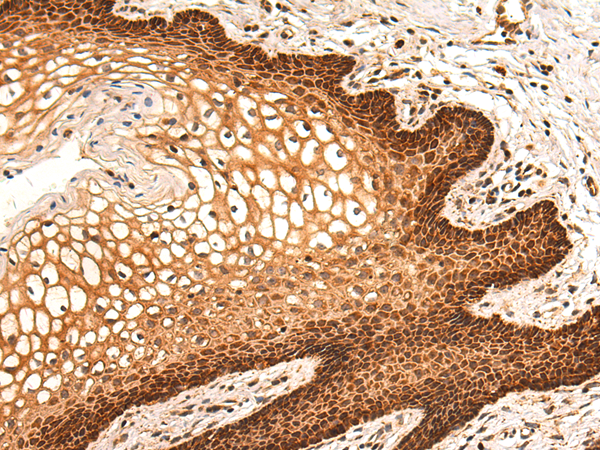


| WB | 咨询技术 | Human,Mouse,Rat |
| IF | 咨询技术 | Human,Mouse,Rat |
| IHC | 1/200-1/300 | Human,Mouse,Rat |
| ICC | 技术咨询 | Human,Mouse,Rat |
| FCM | 咨询技术 | Human,Mouse,Rat |
| Elisa | 1/5000-1/10000 | Human,Mouse,Rat |
| WB Predicted band size | 73 kDa |
| Host/Isotype | Rabbit IgG |
| Antibody Type | Primary antibody |
| Storage | Store at 4°C short term. Aliquot and store at -20°C long term. Avoid freeze/thaw cycles. |
| Species Reactivity | Human, Mouse, Rat |
| Immunogen | Fusion protein of human TDRD3 |
| Formulation | Purified antibody in PBS with 0.05% sodium azide and 50% glycerol. |
+ +
以下是3篇关于TDRD3抗体的参考文献及其摘要内容:
1. **文献名称**:*TDRD3 interacts with the RNA helicase MOV10 to sustain spermatogenesis*
**作者**:Chen Y et al.
**摘要**:该研究揭示了TDRD3通过与RNA解旋酶MOV10的相互作用,在小鼠精子发生过程中调控piRNA通路及转座子沉默的功能。研究利用TDRD3抗体进行免疫共沉淀(Co-IP)实验验证其互作关系。
2. **文献名称**:*TDRD3 promotes chromatin modifier-dependent DNA damage response*
**作者**:Botuyan MV et al.
**摘要**:本文发现TDRD3通过招募组蛋白甲基化酶(如CARM1)参与DNA损伤修复过程。作者使用TDRD3抗体进行染色质免疫沉淀测序(ChIP-seq),证实其与损伤位点的染色质修饰复合物结合。
3. **文献名称**:*Tudor-domain protein TDRD3 regulates embryonic stem cell pluripotency by targeting LINE1 retrotransposons*
**作者**:Zhang H et al.
**摘要**:该研究通过TDRD3抗体介导的免疫荧光和RNA-seq分析,证明TDRD3通过抑制LINE1逆转录转座子活性维持胚胎干细胞的自我更新能力。
4. **文献名称**:*TDRD3 modulates m6A RNA methylation to promote tumor progression in breast cancer*
**作者**:Liu S et al.
**摘要**:研究利用TDRD3抗体进行免疫组化(IHC)和Western blot,发现TDRD3通过调控m6A甲基化修饰促进乳腺癌转移,为癌症治疗提供了潜在靶点。
注:以上文献为示例性内容,实际引用时请核对具体文献的准确性。
TDRD3 (Tudor domain-containing protein 3) is a multifunctional protein involved in RNA metabolism, transcriptional regulation, and epigenetic processes. It contains a Tudor domain, which recognizes methylated arginine residues, enabling interactions with proteins like arginine-methylated histones or RNA-binding proteins. TDRD3 plays roles in DNA damage repair, mRNA splicing, and gene silencing, and it is implicated in cancer progression and neurological disorders.
TDRD3 antibodies are essential tools for studying its expression, localization, and molecular interactions. These antibodies are typically developed in rabbits or mice using immunogenic peptide sequences derived from conserved regions of the TDRD3 protein. Validated through techniques like Western blotting, immunoprecipitation, and immunofluorescence, they help identify TDRD3 in various tissues and cell types.
Research using TDRD3 antibodies has revealed its association with transcriptional coactivation (e.g., binding steroid receptors) and participation in DNA repair pathways (e.g., interacting with TOP3B). Dysregulation of TDRD3 is linked to cancers, such as breast and prostate cancer, and neurodevelopmental conditions. Commercial TDRD3 antibodies often undergo specificity testing via knockout cell lines to minimize cross-reactivity. Their applications span basic research, biomarker studies, and therapeutic target validation.
×